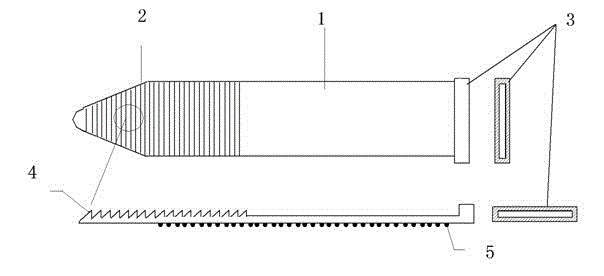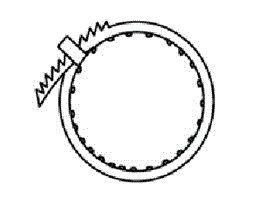Material for making tendon anastomat, tendon anastomat made of material and making method
A stapler and tendon technology, applied in the field of bioabsorbable flexible materials, can solve the problems of complex surgical procedures, difficult operations, and difficult operations, and achieve the effects of improving surgical efficiency, avoiding tendon adhesion, and reducing pain.
- Summary
- Abstract
- Description
- Claims
- Application Information
AI Technical Summary
Problems solved by technology
Method used
Image
Examples
Embodiment 1
[0038] 1. Raw materials:
[0039] (1) Polylactic acid (molecular weight: 100,000, MI=2g / 10min) 70%;
[0040] (2) Polycaprolactone (molecular weight 20000, MI=50g / 10min) 29.5%;
[0041] (3) Simethicone oil (viscosity 50mm 2 / s) 0.5%.
[0042] 2. Manufacturing method:
[0043] (1) Put the polylactic acid and polycaprolactone resin in a vacuum drying oven for 24 h, and the drying conditions are: set temperature 60°C, vacuum degree -0.05 Mpa;
[0044] (2) Proportion the raw materials according to the mass percentage, and then pre-mix evenly to obtain the pre-mixture;
[0045] (3) Melt and blend the premix with a twin-screw extruder. The temperature of each section of the extruder from the barrel to the head is 100, 150, 160, 180, 180, and 175°C, and the screw speed is 100rpm;
[0046] (4) Put the above extruded and granulated materials in a vacuum drying oven to dry for 4~6 h at a temperature of 60°C and a vacuum of -0.05 MPa;
[0047] (5) Use an injection molding machine to...
Embodiment 2
[0050] 1. Raw materials:
[0051] Polylactic acid (molecular weight 80000, MI=5g / 10min) 79%;
[0052] Polycaprolactone (molecular weight 40000, MI=15g / 10min) 20%;
[0053] Simethicone oil (viscosity 100mm 2 / s) 1%.
[0054] 2. Preparation method:
[0055] (1) Put the polylactic acid and polycaprolactone resin in a vacuum drying oven for 24 h, and the drying conditions are: set temperature 60°C, vacuum degree -0.05 Mpa;
[0056] (2) Proportion the raw materials according to the mass percentage, and then pre-mix evenly to obtain the pre-mixture;
[0057] (3) Melt and blend the premix with a twin-screw extruder. The temperature of each section of the extruder from the barrel to the head is 100, 150, 160, 180, 180, and 175°C, and the screw speed is 300rpm;
[0058] (4) Put the above extruded and granulated materials in a vacuum drying oven to dry for 4~6 h at a temperature of 60°C and a vacuum of -0.05 MPa;
[0059] (5) Use an injection molding machine to make a tendon stapl...
Embodiment 3
[0062] 1. Raw materials:
[0063] Polylactic acid (molecular weight 60000, MI=20g / 10min) 78%;
[0064] Polycaprolactone (molecular weight 60000, MI=10g / 10min) 20%;
[0065] Simethicone oil (viscosity 150mm 2 / s) 2%.
[0066] 2. Preparation method:
[0067] (1) Put the polylactic acid and polycaprolactone resin in a vacuum drying oven for 24 h, and the drying conditions are: set temperature 60°C, vacuum degree -0.05 Mpa;
[0068] (2) Proportion the raw materials according to mass percentage, and then pre-mix evenly to obtain a pre-mixture.
[0069] (3) Melt and blend the premix with a twin-screw extruder. The temperature of each section of the extruder from the barrel to the head is 100, 150, 160, 180, 180, and 175°C, and the screw speed is 600rpm.
[0070] (4) Put the extruded and granulated materials above in a vacuum drying oven to dry for 4-6 h at a temperature of 60 °C and a vacuum of -0.05 MPa.
[0071] (5) Use an injection molding machine to make a tendon stapler. ...
PUM
| Property | Measurement | Unit |
|---|---|---|
| Glass transition temperature | aaaaa | aaaaa |
| Melting point | aaaaa | aaaaa |
| The melt flow rate | aaaaa | aaaaa |
Abstract
Description
Claims
Application Information
 Login to View More
Login to View More - R&D
- Intellectual Property
- Life Sciences
- Materials
- Tech Scout
- Unparalleled Data Quality
- Higher Quality Content
- 60% Fewer Hallucinations
Browse by: Latest US Patents, China's latest patents, Technical Efficacy Thesaurus, Application Domain, Technology Topic, Popular Technical Reports.
© 2025 PatSnap. All rights reserved.Legal|Privacy policy|Modern Slavery Act Transparency Statement|Sitemap|About US| Contact US: help@patsnap.com



